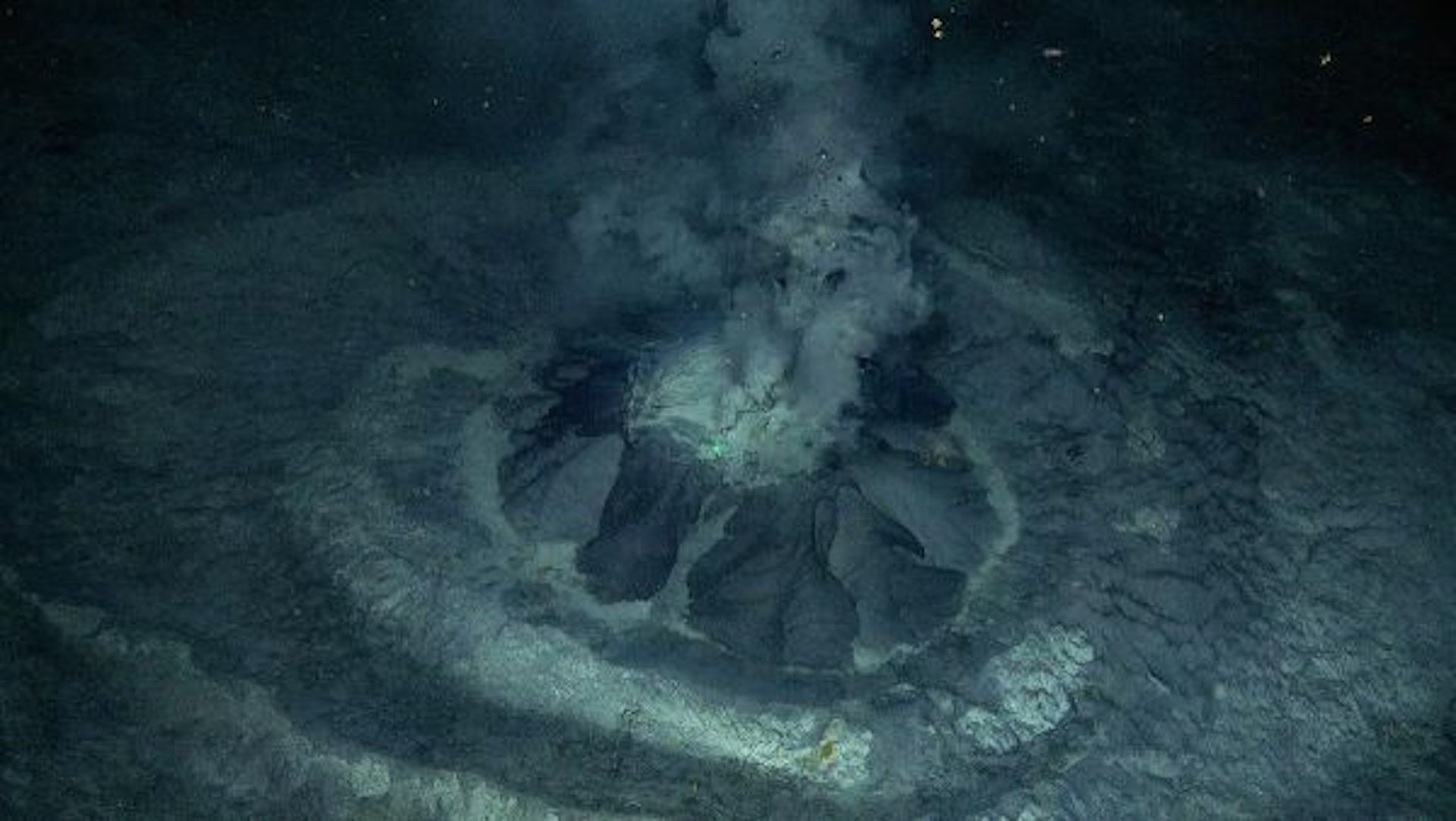Scientists discover giant crater from ice age explosion that has methane-spewing mud volcano inside it
The Borealis Mud Volcano is only the second found in Norwegian waters and releases a continuous stream of methane-rich, muddy liquid from deep below Earth's crust.

Ocean explorers in the Arctic have discovered an underwater volcano spewing mud and methane from inside another, larger crater that probably formed after a catastrophic blowout at the end of the last ice age.
Researchers spotted the unusual feature on Earth about 80 miles (130 kilometers) south of Norway's Bear Island, or Bjørnøya, in the Barents Sea. The volcano, which the team named the Borealis Mud Volcano, is only the second of its kind discovered in Norwegian waters.
"Exploring the seabed and discovering new methane [seeps] is like finding hidden treasures," said Stefan Buenz, a professor at The Arctic University of Norway (University of Tromsø) and co-leader of the Advancing Knowledge of Methane in the Arctic (AKMA) expedition that made the discovery. "Every time we go down to the seabed, we get the feeling that we have just begun to understand the great and incredible diversity of such [seep] systems," Buenz said in a translated statement.
A submarine mud volcano is a geological structure formed by an expulsion of muddy fluid and gas, predominantly methane.
The Borealis Mud Volcano measures roughly 23 feet (7 meters) in diameter and is about 8 feet (2.5 m) tall. On May 7, the scientists used a remote-controlled rover to capture footage of the small mount continuously emitting a muddy fluid, which the researchers say is rich in methane. Methane is a powerful greenhouse gas once it reaches the Earth's atmosphere and contributes to climate change.
Related: Space volcanoes: Origins, variants and eruptions
The volcano sits in the middle of another, much larger crater, which is 984 feet (300 m) wide and 82 feet (25 m) deep. The exceptional formation sits 1,312 feet (400 m) below the sea surface and likely resulted from a sudden and massive methane eruption after the last glacial period, 18,000 years ago, according to the statement.
Get the Space.com Newsletter
Breaking space news, the latest updates on rocket launches, skywatching events and more!
"Seeing an underwater eruption in real time reminds me how 'alive' our planet is," Giuliana Panieri, a professor in geology at The Arctic University of Norway and the leader of the expedition, said in the statement.
The researchers found the volcano's flanks teeming with animal life feeding off carbonate crusts — mineral crusts formed when microorganisms consume methane and produce bicarbonate as a byproduct, according to a 2019 study in the International Journal of Environmental Research and Public Health — that formed thousands of years ago. They spied sea anemones, sponges, corals, starfish, sea spiders and diverse crustaceans.
The only other known mud volcano in Norwegian waters is the Håkon Mosby volcano. This 0.6-mile-wide (1 km) feature was discovered 4,100 feet (1,250 m) below the water’s surface on the seabed south of Svalbard in 1995, according to the University of Bergen's Center for Geobiology. Underwater mud volcanoes are difficult to spot and map, but researchers estimate there could be hundreds or thousands of them on the seafloor globally, according to a 2021 chapter in Lecture Notes in Earth System Sciences.
These volcanoes provide a rare window into geological processes occurring deep below Earth's crust, since they spout mainly water, minerals and fine sediment from these depths. They also offer clues about previous environments and conditions on Earth, and could give an insight into systems on other planets, Panieri said.
The AKMA expedition is a three-part mission investigating methane activity in Arctic waters. Scientists are now on the lookout for similar formations in the Arctic. "We do not rule out the possibility of discovering other mud volcanoes in the Barents Sea," Panieri said.
Join our Space Forums to keep talking space on the latest missions, night sky and more! And if you have a news tip, correction or comment, let us know at: community@space.com.

Sascha is a U.K.-based trainee staff writer at Live Science. She holds a bachelor’s degree in biology from the University of Southampton in England and a master’s degree in science communication from Imperial College London. Her work has appeared in The Guardian and the health website Zoe. Besides writing, she enjoys playing tennis, bread-making and browsing second-hand shops for hidden gems.
-
rod With all the methane released in activity like this, what happened to the climate change model? Does modern technology create more methane or does nature, today as well as in the remote past? :)Reply -
rod Some may claim modern technology produces more but that should be compared with all the activity documented in the fossil record from Cambrian to Cenozoic strata, including ice age volcanic activity. This should include the increasing solar energy output known as the Faint Young Sun.Reply -
billslugg Here is global methane budget. Humans are responsible for 60% of global emissions. The yearly increase in the atmosphere, 37 million tons, is about a tenth of what humans emit.Reply
https://www.globalcarbonproject.org/methanebudget/20/files/MethaneInfographic2020.png -
rod Reply
Good chart, timeline is 2008-2017. I was thinking about geologic time scales like Cambrian through Ice Age. Much evidence for *climate change* documented in the strata.billslugg said:Here is global methane budget. Humans are responsible for 60% of global emissions. The yearly increase in the atmosphere, 37 million tons, is about a tenth of what humans emit.
https://www.globalcarbonproject.org/methanebudget/20/files/MethaneInfographic2020.png










